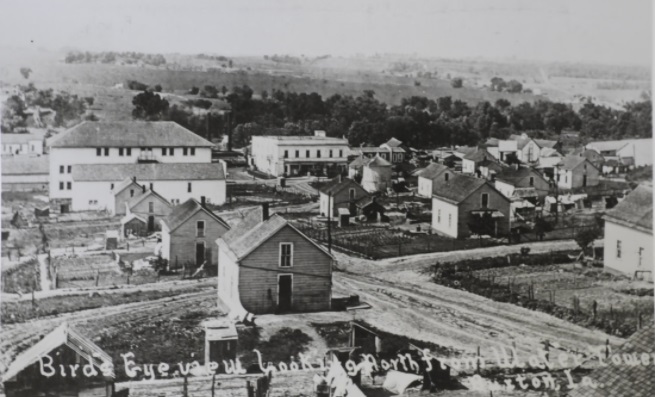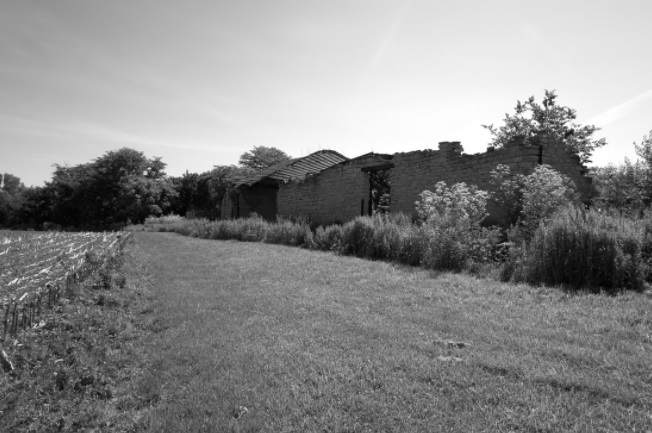
In 1900 the Consolidation Coal Company established one of the most unique towns in Iowa: Buxton. Spanning 8,600 acres in Monroe County and 1,600 acres in Mahaska County, along with a population that grew to 5,000, Buxton became the largest unincorporated town in Iowa.
Though the town itself was different from most other coal mining towns, Buxton is renowned for its large African American population. For the first 10 years, African Americans made 55 percent of the population and remained the largest ethnic group until 1914.
A Planned Town
The typical Iowa mining town at the turn of the twentieth century featured hastily constructed houses, a company store, a small school, a tavern, a union hall and a church. Buxton was not “typical.” Buxton residents enjoyed 1-1/2 story houses that were maintained by the company, a company store that rivaled department stores, three two-story schoolhouses, a two-story high school, a three-story YMCA and more than 10 churches.
According the Sept. 18, 1903, edition of the Iowa State Bystander, Superintendent Ben C. Buxton “designed and superintended the laying out of the town, the plans and construction of the buildings, the location and equipment of the mines, the water supply, the drainage and all the many interesting details . . . .”

A Prosperous Town
Mining was often seasonal, which resulted in reduced demand for coal in the warmer months, but this was not the case in Buxton. Since the Consolidation Coal Company was owned by the Chicago and North Western Railroad and trains required a constant supply of coal, men in Buxton worked year-round, earning $40 to $100 every two weeks.
“The miners received excellent pay according to the economy at that time,” said Reuben Gaines Jr., a successful African American businessman in Buxton, in an undated memoir. “In any event or manner, the money flowed freely.”
There was no shortage of ways residents in Buxton could spend money. They could shop at more than 40 independent businesses, plus the company store.
“You could buy anything in that company store, from a diaper pin to a coffin,” said Buxton resident Carl Kietzman. “The company had its own morticians and own mortuary. They had a shoe department, shoe repair department, furniture, hardware, groceries, cooking ware, clothing, and yard goods. The company store had a bank in it, the company office, a soda fountain where they served lunches.”
A Racially Integrated Town
Former residents — both black and white — agreed that Buxton was integrated and that any segregation that did exist, such as separate churches, was by choice. The company awarded housing on a first-come, first-served basis. Sixteen of the 85 company store clerks were black, and black men and white men worked in the mines in neighboring “rooms.” Black children and white children were taught by black and white teachers, and residents attended public events — baseball games, movies, parades and picnics — sitting or standing wherever they desired.

Residents also remembered interracial marriages.
“There were a lot of interracial marriages down there,” said Oliver Burkett, an African American resident. “There was Charlie King. He was a black man. He married a white woman. Hobe Armstrong, he was a black man, and he married a white woman. George Morrison, he was married to a white woman.” Carl Kietzman was married to an African American woman.
African Americans Thrived
In addition to miners, there were many African American professionals and business owners in Buxton. African American professionals included doctors, lawyers, a dentist, pharmacists, constables, teachers, commercial and rental property owners, an insurance agent, company store clerks and at least one store manager, a bank manager, a cigar maker, a postmaster, a mine engineer, two justices of the peace, barbers, a tailor and many entrepreneurs.
Black-owned businesses included hotels, restaurants, grocery stores, confectionaries, a bakery, drug stores, pool halls, dance halls, a music store, a photography and printing business, a meat market or two, millinery shops and at least four newspapers.
The End of Buxton
By 1918 the mines near Buxton were almost completely played out, and the company had moved operations to Consol, Iowa, located 18 miles southwest of Buxton, and to Bucknell/Haydock. By 1922 Buxton was a ghost town.
Miners and their families moved to other cities in Iowa and beyond in search of work or moved to the company’s new towns. But by 1927 the continuing decline in coal demand and the negative perception of Iowa coal, plus labor problems, resulted in the shutdown of remaining mines. Consol and Bucknell/Haydock, like Buxton, were gone.
For many African American residents, leaving Buxton was like stepping back in time. Jim Crow laws, segregation, extreme racism and menial jobs awaited them, leaving many feeling like Susie Robinson.
“There’s no place that’s ever going to be like Buxton,” said Robinson. “That’s the best place that I’ve ever been, Buxton.”

Even before moving to Iowa, Rachelle Chase was fascinated by the history of Buxton, Iowa, and its former residents. Now that she has become an Iowa resident, she is determined to help share their story. Chase is the author of multiple fiction books and the non-fiction book, “Lost Buxton.” To learn more about Chase and her work, visit her website. This article is published by permission of Hometown Heritage.


















We lived close to Buxton when in Chariton. Lou had a lady 100 years old in the parish who lived in the town, and her stories reflected what you wrote. We donated a Buxton book to our library. Is that where you got info??
Hi, Lois. No, my research was based on audio cassette interviews done by Dorothy Schwieder and her team in 1980 as part of a grant received from the Department of Interior to study Buxton. I did use their book, “Buxton: A Black Utopia in the Heartland” — and many other articles and books — while researching my book, “Lost Buxton.” I wish I could have met the woman you mentioned. Thanks for stopping by.
I once knew a lady in Ottumwa who was born and raised in Buxton. I must confess to a bit of latent racism back in the early ’80s as my first thoughts were how erudite and articulate she was for a black person. I have since come to terms with and have shed most of my old attitudes about race. I didn’t particularly consider myself racist then. Indeed, I thought I was quite hip and progressive for that time and place. I can just about kick myself for being so naive and ignorant not only about the society just outside of white-bread America but also quite ignorant about the workings of my own mind. We all progress from darkness into light, or at least we are supposed to. My own personal experience has taught me that whoever starts a sentence with, “I’m not racist, but . . . ,” sure as heck is racist. I digress. Coming back to the topic of Buxton, the elderly black lady I knew who was raised there put it all in no uncertain terms. She had no idea what racism was or what most of white America thought about blacks until her family moved from Buxton. I forget who they are now, but she informed me there was no small list of notable black people from Buxton who became prominent citizens, not just in the black community but in Iowa at large. I would be remiss if I didn’t mention our own Roy White’s family had moved here from Buxton.
Hi, Nick – that woman’s experience after leaving Buxton that you mentioned was one I heard numerous African American residents share. Thank you for sharing you journey “into light” — and for reading the article.
I grew up in Davenport, Iowa, in the 1980s-199’s. I’m of mixed race descent. I was in the process of researching African-American history in Iowa when your link popped up. I enjoyed learning about Buxton,Iowa through your article, such a beautiful story/history of race relations. Thank you for sharing.
Hi, Rebecca. Thank you for the note, and I’m so glad to hear you enjoyed the article. Buxton truly was a remarkable town. I’ve only lived in Iowa 3 years so I, too, am enjoying learning about African-American history here. Have you checked out “Outside In: African-American History in Iowa 1838-2000”?
I find the story of Buxton to be quite interesting. I actually visited the site where the town of Buxton was years ago. I was completely unaware of its existence until the man with whom I was there to see told me the story. I was buying scrap metal and old cars from the man when he said to me, “You are standing in downtown Buxton.” I looked around and could see little trace of a town. Since then I have read and studied a lot of local history. From what I have gathered in speaking with many “old timers” in the area, there is a link to the coal mines of Buxton and the three pyramids in Attica. Many Swedish people came to the area to work the mines as well. This is truly a fascinating story. Thank you for your work. I have truly enjoyed learning a bit of local history. Sadly, so many people that grew up in this area are completely unaware of the history in our own community.